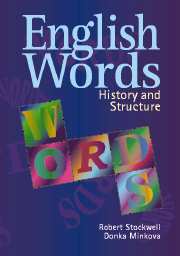Book contents
- Frontmatter
- Contents
- An introduction to the textbook
- Chapter One Word origins
- Chapter Two The background of English
- Chapter Three Composition of the Early Modern and Modern English vocabulary
- Chapter Four Smaller than words: morphemes and types of morphemes
- Chapter Five Allomorphy, phonetics, and affixation
- Chapter Six Replacement rules
- Chapter Seven Deletion rules and other kinds of allomorphy
- Chapter Eight Fossilized allomorphy: false cognates and other etymological pitfalls
- Chapter Nine Semantic change and semantic guesswork
- Chapter 10 The pronunciation of classical words in English
- Appendix I An introduction to dictionaries
- Appendix II Morpheme list
- Index
Chapter Three - Composition of the Early Modern and Modern English vocabulary
Published online by Cambridge University Press: 05 September 2012
- Frontmatter
- Contents
- An introduction to the textbook
- Chapter One Word origins
- Chapter Two The background of English
- Chapter Three Composition of the Early Modern and Modern English vocabulary
- Chapter Four Smaller than words: morphemes and types of morphemes
- Chapter Five Allomorphy, phonetics, and affixation
- Chapter Six Replacement rules
- Chapter Seven Deletion rules and other kinds of allomorphy
- Chapter Eight Fossilized allomorphy: false cognates and other etymological pitfalls
- Chapter Nine Semantic change and semantic guesswork
- Chapter 10 The pronunciation of classical words in English
- Appendix I An introduction to dictionaries
- Appendix II Morpheme list
- Index
Summary
The Early Modern English cultural scene
The linguistic period identified as Early Modern English began some time during the second half of the fifteenth century. There is no single historical event comparable to the Norman invasion of 1066 for Middle English which can be taken conveniently as the boundary between Middle and Early Modern English. The language changes which characterize the transition of Middle to Early Modern English coincide chronologically with several major cultural and social changes. The most notable among these is the introduction of the printing press, by Sir William Caxton, in 1476. This year is commonly taken as the cut-off date because it marks a turning point in the production and accessibility of books. Another historical event which coincides roughly with the beginning of Early Modern English is the discovery of the New World in 1492. While its effect on our word stock was not as immediate as the availability of printed books, the discovery of the Americas has had extraordinary consequences for the composition of the English lexicon.
The end-point of Early Middle English coincides with two important events which occurred in the second half of the eighteenth century. We have already mentioned the appearance of the first really influential dictionary of English, the Dictionary of the English Language in two volumes by Samuel Johnson in 1755. That dictionary boosted enormously the prestige of English lexicographical research.
- Type
- Chapter
- Information
- English WordsHistory and Structure, pp. 39 - 55Publisher: Cambridge University PressPrint publication year: 2001



